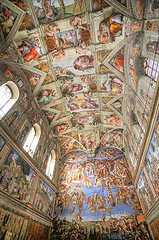
That’s a quote from the new, non-fiction book The Sistine Secrets, a work sure to change the way many look at the Sistine Chapel and the great artist Michelangelo. And what secrets does this book reveal? That not only was Michelangelo well-versed in Judaism but that he included numerous Judaic symbols and messages of religious reconciliation in his Sistine Chapel frescoes. While the artist’s proclivity for hidden messages has been documented before, these new revelations are absolutely fascinating!
How did Michelangelo know so much about Judaism? What was his motivation to weave these messages into his paintings? How can you discover these designs and messages for yourself when you visit the Vatican? The answers to these questions and many more in our May issue where we have an extensive interview with Roy Doliner, who co-authored the book with Rabbi Benjamin Blech. Here are some fascinating facts from their book:
- The structure of the Sistine Chapel (built before Michelangelo arrived on the scene) is an exact copy of the Holy of Holies in Solomon’s ancient Temple in Jerusalem. This could be viewed as an affront to Judaism as the Talmud prohibits a functioning copy of the temple to be built anywhere but in Jerusalem.
- Michelangelo, a sculptor by trade and passion, had never frescoed before being charged with creating the largest fresco in the world, some 12,000 square feet. The artist had to pay for his supplies out of his own earnings. A fact worth noting when Pope Julius II requested more royal blue and gold, the most expensive colors, be added to the frescoes.
- Pope Julius II asked Michelangelo to place Jesus over the door where the Pope enters the Sistine Chapel. Instead, that’s where the artist painted the Jewish prophet Zechariah. While the authors of The Sistine Secrets attribute Michelangelo’s decision may have had multiple reasons, they point out that it may have been a commentary on church corruption. They write, “Zechariah warned the corrupt priesthood of the Second Holy Temple: ‘Open your doors, O Lebanon, that the fire may devour your cedars’ (Zechariah II:I).”
